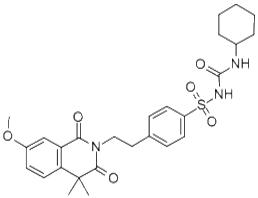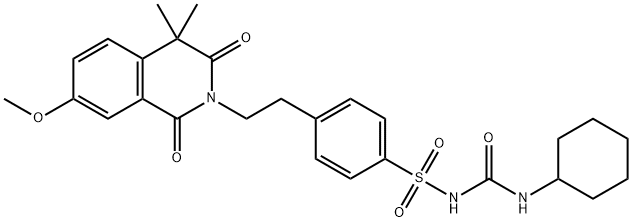
Gliquidone
| Price | $1 |
| Package | 1KG |
| Min. Order: | 1G |
| Supply Ability: | 100KG |
| Update Time: | 2019-07-06 |
Product Details
| Product Name: Gliquidone | CAS No.: 33342-05-1 |
| Min. Order: 1G | Purity: 98% |
| Supply Ability: 100KG | Release date: 2019/07/06 |
AD68
| Gliquidone Basic information |
| Oral hypoglycemic agents Diabetes Medicine interactions Side effects Precautions Uses |
| Product Name: | Gliquidone |
| Synonyms: | ,4-dimethyl-1,3-dioxo-2(1h)-isoquinolinyl)ethyl)-;ardf26;ardf26se;benzenesulfonamide,n-((cyclohexylamino)carbonyl)-4-(2-(3,4-dihydro-7-methoxy-4;GLIQUIDONE;GLIQUIDONE 99%;Gliquidone Tablets;Glurenorm |
| CAS: | 33342-05-1 |
| MF: | C27H33N3O6S |
| MW: | 527.63 |
| EINECS: | 251-463-2 |
| Product Categories: | Active Pharmaceutical Ingredients;API;Glurenorm |
| Mol File: | 33342-05-1.mol |
 |
|
| Gliquidone Chemical Properties |
| Melting point | 179 °C |
| Merck | 14,4443 |
| CAS DataBase Reference | 33342-05-1(CAS DataBase Reference) |
| Safety Information |
| Safety Statements | 24/25 |
| RTECS | DB1584250 |
| MSDS Information |
| Gliquidone Usage And Synthesis |
| Oral hypoglycemic agents | Gliquidone is an oral hypoglycemic agent, and was called as the second generation sulfonylurea oral hypoglycemic drug together with glyburide, gliclazide and glipizide, primarily for the treatment of non-insulin-dependent (namely, II type) diabetes. Its mechanism of action is the same as other sulfonylurea drugs and can stimulate insulin secretion from pancreatic β cells, and can enhance the action of insulin, enhance the sensitivity of tissues to insulin action, increase the number of insulin receptor and strengthen post-receptor action of insulin. During the early phase of treatment, it is mainly used for promoting the secretion of endogenous insulin; after a period of time of treatment, its main role is to improve the sensitivity of peripheral tissues to insulin. Diabetic nephropathy is one of the late complications of diabetes while gliquidone is the only sulfonylurea drugs that not affected by renal function and therefore can be applied to diabetic patients with impaired renal function. It is the primary-choice of drug for the treatment of patients of non-insulin dependent diabetes accompanied with insufficiency of renal function. Gliquidone is characterized by short duration of action and seldom undergoing of renal excretion with a small dose being able to control postprandial blood glucose. Oral absorption is quick and complete. After the first oral administration of 30mg, the plasma concentration reaches its peak value, 500~700μg/L after 2 to 3 hours. The efficacy onset occurs at 1 hour after administration, the maximal effect can be extended up to 2 to 3 hours with the duration of 8 hours and the plasma protein binding rate being 99% and the half-life of about 1.5 hours. It is mainly metabolized in the liver through hydroxylation or demethylation with its metabolites having no significant hypoglycemic activity and most of them being discharged through feces via biliary while only 5% being subject to renal excretion. This product has mild effect and can be subject to dose adjustment timely based on blood sugar or urine glucose and rarely cause hypoglycemia reaction. It is suitable for the treatment of adult-type mild, moderate diabetes which can’t be simply treated through diet, especially for patients with renal insufficiency. |
| Diabetes | Diabetes is a group of syndrome of carbohydrate, fat, water and electrolyte metabolic disorder caused by the interaction of genetic and environmental factors, absolute or relative lack of insulin, and reduced cellular insulin sensitivity. According to the suggestion of ADA (in 1997) and WHO (in 1999), the diabetes are divided into four types, namely type 1 diabetes, type 2 diabetes, other specific types, and gestational diabetes. The vast majority belongs to type 2 diabetes (non-insulin-dependent diabetes mellitus, NIDDM), type 1 diabetes (insulin-dependent, IDDM) accounted for only 10% to 15%. The main clinical manifestations: polydipsia, polyphagia, polyuria, weight loss, fatigue, etc., advanced case is often accompanied with cataracts, abnormal reflexes in depth of feeling, urinary retention and skin infections. Type 1 " three polys and one little " is more obvious and is susceptible; the majority of patients with type 2 have no typical performances and is mainly in the form of complications or complications. Common complication mainly includes diabetic ketoacidosis and diabetic nonketotic hyperosmotic syndrome. The above information is edited by the chemicalbook of Dai Xiongfeng. |
| Medicine interactions | The hypoglycemic effect of gliquidone can be enhanced by salicylates, sulfonamides, phenylbutazone, anti-tuberculosis drugs, tetracyclines, monoamine oxidase inhibitors, β receptor blockers and cyclophosphamide. Combination with chlorpromazine, sympathomimetic drugs, corticosteroids, thyroid hormones, oral contraceptives and niacin preparations can reduce the hypoglycemic effect of this product. |
| Side effects | This product can be well tolerated. There is rare case of hypoglycemia during the treatment. There are only individual cases of patients who get gastrointestinal symptoms and skin allergy. Rare symptoms also include rash, jaundice, liver damage, bone marrow suppression, neutropenia, thrombocytopenia psychosis. |
| Precautions | 1. Only 5% of this product is excreted through the kidneys. Therefore, for patients of diabetes with mild to moderate renal insufficiency, it is significantly better to adopt gliquidone rather than other sulfonylurea drug. However, for patients of severe renal dysfunction, insulin is still appropriate. Patients of pregnancy and those who are allergic to sulfonylureas, patients of insulin-dependent diabetes mellitus, patients of pre-coma and coma of diabetes, diabetic patients with acidosis or ketosis should be banned. 2. Children and lactating women should apply with caution. During medication, elderly should start from small dose and gradually adjust the dose. 3. In case of hypoglycemia reaction, the patients should immediately have carbohydrates diet. If hypoglycemia continues, the patients should consider discontinuing. |
| Uses | It is a kind of hypoglycemic agents and can be used for the treatment of non-insulin-dependent diabetes. |
| Uses | Antidiabetic |
Company Profile Introduction
Established in 2014,Career Henan Chemical Co. is a manufacturerspecializing in the sale of fine chemicals.
Mainly deals in the sales of:
Pharmaceutical intermediates
OLED intermediates:
Pharmaceutical intermediates;
OLED intermediates;
You may like
Recommended supplier
| Product name | Price | Suppliers | Update time | |
|---|---|---|---|---|
| $50.00/1kg |
VIP1Y
|
Ouhuang Engineering Materials (Hubei) Co., Ltd
|
2024-04-15 | |
| $0.00/1KG |
VIP3Y
|
WUHAN FORTUNA CHEMICAL CO., LTD
|
2023-01-31 | |
| $0.00/25KG |
VIP4Y
|
Hebei Mojin Biotechnology Co., Ltd
|
2022-07-15 | |
| $85.00/1KG |
XINGTAI XINGJIU NEW MATERIAL TECHNOLOGY CO., LTD
|
2021-12-20 | ||
| $1.90/1KG |
VIP3Y
|
Hebei Guanlang Biotechnology Co,.LTD
|
2021-08-25 | |
| $15.00/1KG |
Zhuozhou Wenxi import and Export Co., Ltd
|
2021-07-10 | ||
| $1.10/1g |
VIP3Y
|
Dideu Industries Group Limited
|
2021-06-15 | |
| $1143.00/1KG |
VIP3Y
|
Baoji Guokang Bio-Technology Co., Ltd.
|
2021-06-05 | |
| $1880.00/1KG |
VIP5Y
|
Shaanxi Dideu Medichem Co. Ltd
|
2020-07-07 | |
| $10.00/1KG |
Hubei XinRunde Chemical Co., Ltd.
|
2018-03-29 |
- Since: 2014-12-17
- Address: No.967,15th Floor,Unit 7, Building 1, No.70 of DianChang Road, High-tech Development Zone, Zhengzho
INQUIRY
杨俊青
15093356674
sales@coreychem.com
15093356674
sales@coreychem.com








 China
China